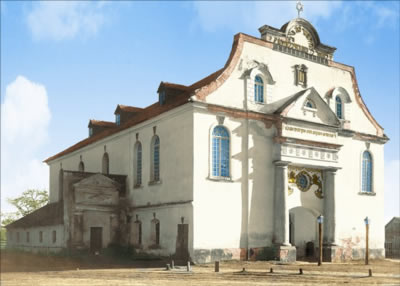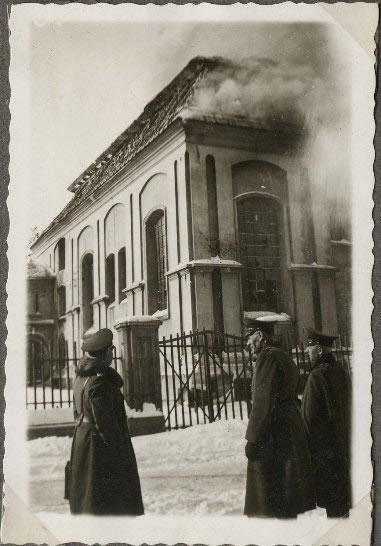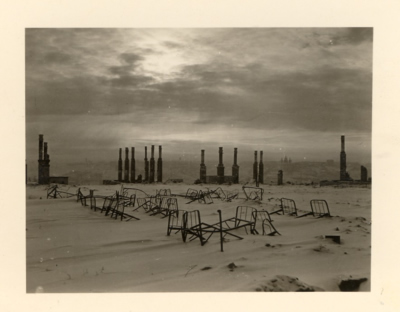Search our Archives:
» Home
» History
» Holidays
» Humor
» Places
» Thought
» Opinion & Society
» Writings
» Customs
» Misc.
|
A Lost World… for sale
By Tomasz Wisniewski
History can mete out justice, but unfortunately it often does not manage to punish the criminals. Only now, years after the event, has it become obvious that many photos taken by German soldiers serve as clear evidence of the perpetration of criminal acts.
"A Lost Order", "That Which Is No More", "Snapshots of Genocide", "The European Union is Nothing New" – these are all exhibitions that have been mounted by the In Search of Poland Society of which I am a co-founder. They tell of the cultural, national, and religious diversity of central-eastern Europe. This region whose rich, unparalleled multi-cultural legacy was painstakingly put together over centuries - this has gone forever. It was dealt a decisive blow by the Second World War, and particularly by the Holocaust which destroyed Jewish society almost entirely. The remnants of this Atlantis were finally engulfed by the deluge of communism which after 1945 swept away everything that provided a link to historical continuity, tradition, local culture and ancient customs.

Aeriel View

Restored Synagogue
A Lost order
The epicentre of that world of relative harmony and order was located in interwar Poland. The Jagiellonian gene had for centuries been lodged deep in the psyche of its inhabitants, nurturing the traditions of fifteenth and sixteenth century Poland under the rule of the Jagiellonian dynasty - the Polish kings of Lithuanian ancestry. In those days Poland was known as the Republic of Two Nations (Poland and Lithuania) and for centuries it developed traditions of tolerance towards other cultures, religions and nationalities. It was the first state in the history of Europe not to advocate ethnic uniformity, the dominance of one nationality over another, nor to practice the imposition of one favoured language or religion.
The maintenance of internal peace in such a - for those times - unique state demanded from its politicians a great sense of responsibility and great skills, if the delicate balance between the individual parts of the federation and their at times conflicting interests were to be permanently maintained. Over the years this arduous work allowed people to develop such valuable qualities and skills as tolerance, the ability to compromise and work together regardless of individual differences, as well as loyalty to one's fellow citizens and the state. Such qualities are very much lacking nowadays. You do not need an especially vivid imagination to discern in this Jagiellonian state the prototype of the present-day European Union.
Germans auction off their family memories
How paradoxical that the last records documenting that world in detail were made not by pre-war photographers, ethnographers, tourist or historians, but by … Wehrmacht soldiers. This they did almost literally "the day before" the destruction of that whole world and those who inhabited it. It was, of course, the Jews who suffered most in this inhuman slaughter, but together with them an entire, ancient social order was wrecked by this catastrophe and its once harmonious equilibrium left lying in the rubble of the aftermath. A German soldier setting off to war with Poland in September 1939 would, in addition to his military equipment, have also taken with him the obligatory photo of his sweetheart and a camera. After all, the war was going to be short and sweet and he simply had to bring home some proof of his heroism.

The fire of the synagogue under German control… 1940

The fire of the synagogue in Zolkiew under German control 1941

The synagogue in Lubaczow before and…

and after the fire 1939

Posing at front of the burnt Bialystok synagogue 1941

German soldiers posing inside of the burned synagogue in Lodz
"Snapshots of Genocide" is the title of an article that appeared in the weekly magazine "Polityka". It is also the name of an exhibition in which I illustrated the final days of the Jews in Poland with photographs taken by Wehrmacht soldiers (or possibly other formations such as the SS, the Luftwaffe and the Waffen SS). I acquired most of these photos at auctions in Germany. Significantly, the sellers did not want me to mention their names. When I explained that I was collecting material for an article, they explained that they were just dealers in old photographs and postcards - buying and selling, but not knowing who took the pictures.
At the moment we are witnessing an unusual sociological phenomenon – one quite without precedent. On eBay's German website, German memories are being disposed of wholesale. Every month wartime photos taken by German soldiers come up for auction.

From the Destruction

Having Fun with a Jew

German Soldiers Joking

A Jew Crawls

Starving on the Streets

Public Hanging
It is, I think, safe to say that the photos in a family album are among the most precious souvenirs that a family might possess and that they are not the kind of thing you put up for sale. And yet thousands of Germans are selling off their family photo albums which, alongside the usual photos of holidays in the countryside and such other domestic occasions, also contain photos of military campaigns. What is more, according to a friend of mine, a collector from Hamburg - many families are even shamefacedly throwing such albums out with the rubbish.
On several occasions I have come across complete German family albums containing photos with captions such as "polnische Juden in einer kleinen polnischen Stadt" [Polish Jews in a small Polish town]. However, the name of the owner of the album, the person who took the photos, has always been erased. On one occasion, after having made payment and engaged in a friendly and most courteous exchange of letters, I wrote to Dieter R., who had sold me the album, and asked him where he had obtained it. He never has sent me a reply.
On two adjacent pages of this album, alongside photos of a stork on the roof of a peasant cottage, there is a photograph of a terrified orthodox Jew, his head bowed down, his eyes transfixed by fear; in the other photograph we see next to some cheery soldiers drinking beer . . . the corpses of several small children lying on the edge of a crater made by an exploding shell. These are among the few photos in existence on which copyright will never be enforced – if they are ever published, no one is going to come forward claiming author's rights. These images depict a world on the very eve of destruction and point an accusing finger at the murderers.
Evidence of a crime
I have managed to establish that some of these photos were taken during the first days of the autumn of 1939, while others come from a later period in which sealed off districts had already been set up. Some have captions such as 'Lublin', 'Warsaw', 'Białystok', 'Kraków'. To begin with the Jews were exploited as a free source of labour. The army, police and the German administration fell over themselves to employ vast numbers of Jewish workers, but their ultimate fate had already been decided.
Shooting Jews on the street was an everyday occurrence, but no one ever photographed such incidents. German law forbade the depiction of such crimes. Much documentation dealing with this matter has survived, such as the forms which had to be signed by the SS men taking part in the Aktion Reinhard. These forms forbade in the strictest terms the taking of any photographs during this operation in which the Jewish population of Lublin was liquidated on 18 July 1942. The photos taken during those years do not show the horror of the times, but merely hint at the imminent act of destruction.
On the website of the Yad Vashem Museum in Jerusalem there is a display of photos from the Warsaw Ghetto with the commentary: "After the closure of the Ghetto in November 1940, it became an anthropological attraction for many soldiers...". The ghetto became a peep-show for taking "sensational or amusing photos". Is there then any point in asking who took these photos? Does it matter whether they were taken by 20-year-old Hans, or Klaus who was twice his age? Whatever the answer, we are confronted here with the mystery of human nature. What kind of mentality had taken hold of these people, that they could bring back home to their sweethearts such photographs as a memento of their military campaign?
The famous Wehrmachtsausstellung exhibition (War of Extermination: Crimes of the Wehrmacht 1941-1945) claims that it was not only special units such as the Einsatzgruppen that murdered Jews, but that soldiers from the "chivalrous" Wehrmacht also took part. This exhibition, that has been on show since 1995 was organised by the Institute for Social Research in Hamburg and has succeeded in bringing about a reappraisal of German crimes committed during the Second World War. It was not just the system and Nazi ideology that was guilty, but ordinary, often anonymous, individuals were also responsible. Until the opening of this exhibition, there was a tendency to blame everything on the representatives of the political elite. It was enough to condemn the Nazi institutions, pass judgement on various individuals and accuse the Nazi authorities, but not dwell any further on the nature of German identity nor on the responsibility of ordinary people.

Desolation After War
History can mete out justice, but unfortunately it often does not manage to punish the criminals. Only now, years after the event, has it become obvious that many photos taken by German soldiers serve as clear evidence of the perpetration of criminal acts. How else are we to interpret photos showing the torching of the synagogues in Łęczyca, Żółkiew, or Lubaczów?
It was the Germans who created the most detailed photographic "documentation" of the Europe they occupied and filled with death and destruction. Up until now we have only seen the kind of propaganda photos that show Wehrmacht soldiers feeding starving Polish children, but the situation is beginning to change. The children and grandchildren of these soldiers are now disposing of these photos in something of a panic, no doubt unaware that they can provide history and the world with clear and positive proof of the crimes that were committed. Such photos have not come to light hitherto; for years they were carefully hidden away like treasured relicts, often as a visual memento of the family's chivalrous military traditions, but now they have assumed the character of material evidence in a criminal case.
It was the criminals themselves who recorded the liquidation of the old order and who created a photographic documentation of the synagogues and cemeteries they were about to wipe off the face of the earth. It was they who photographed the terrible scenes in the ghettos and extermination camps and who were the final witnesses to the crimes they simultaneously committed and preserved for posterity. A photograph in a family album depicting a German soldier in a blazing synagogue – is this not evidence for use in a trial that has never taken place? This time it is not just shadowy, ill-defined Nazis who are involved, but ordinary "decent" Germans who set off for a bloody war as if they were going on holiday.
* * * * *
I wanted to talk to you in my own way and in a rather different language, not just about the lost world of the Polish and eastern European jewish shtetl, but about a whole lost social order which prevailed there for centuries and for which I long like a little child. This world is close to me in every way; in its scale and proportions it was finely balanced and rather human and, in its own fashion, quite admirable. This 'Lost Atlantis' is not a land that has disappeared, but one to which we must continually return and which we can draw on to renew and strengthen our humanity.
Tomasz Wisniewski
Białystok, Poland
In Search of Poland Society www.szukamypolski.com/index.php?l=english
Exibitions www.szukamypolski.com/wystawy/
Jews – multimedia www.szukamypolski.com/zydy/
Bagnowka www.bagnowka.com
~~~~~~~
from the June 2007 Edition of the Jewish Magazine
|
|
Please let us know if you see something unsavory on the Google Ads and we will have them removed. Email us with the offensive URL (www.something.com)
|
|









